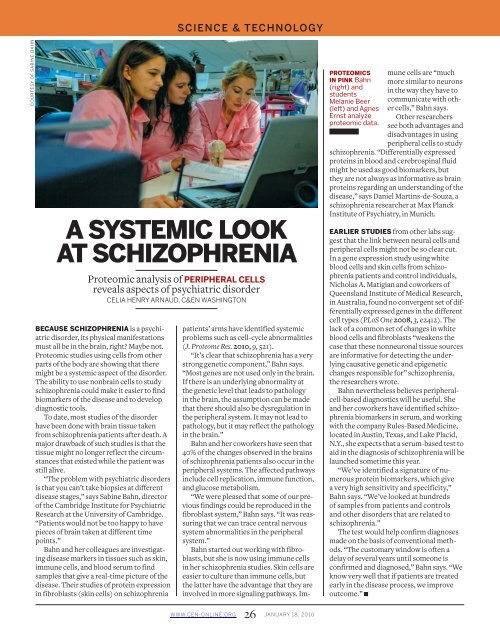Chemical & Engineering News Digital Edition - January 18, 2010
Chemical & Engineering News Digital Edition - January 18, 2010
Chemical & Engineering News Digital Edition - January 18, 2010
Create successful ePaper yourself
Turn your PDF publications into a flip-book with our unique Google optimized e-Paper software.
COURTESY OF SABINE BAHN<br />
BECAUSE SCHIZOPHRENIA is a psychiatric<br />
disorder, its physical manifestations<br />
must all be in the brain, right? Maybe not.<br />
Proteomic studies using cells from other<br />
parts of the body are showing that there<br />
might be a systemic aspect of the disorder.<br />
The ability to use nonbrain cells to study<br />
schizophrenia could make it easier to find<br />
biomarkers of the disease and to develop<br />
diagnostic tools.<br />
To date, most studies of the disorder<br />
have been done with brain tissue taken<br />
from schizophrenia patients after death. A<br />
major drawback of such studies is that the<br />
tissue might no longer reflect the circumstances<br />
that existed while the patient was<br />
still alive.<br />
“The problem with psychiatric disorders<br />
is that you can’t take biopsies at different<br />
disease stages,” says Sabine Bahn, director<br />
of the Cambridge Institute for Psychiatric<br />
Research at the University of Cambridge.<br />
“Patients would not be too happy to have<br />
pieces of brain taken at different time<br />
points.”<br />
Bahn and her colleagues are investigating<br />
disease markers in tissues such as skin,<br />
immune cells, and blood serum to find<br />
samples that give a real-time picture of the<br />
disease. Their studies of protein expression<br />
in fibroblasts (skin cells) on schizophrenia<br />
SCIENCE & TECHNOLOGY<br />
A SYSTEMIC LOOK<br />
AT SCHIZOPHRENIA<br />
Proteomic analysis of PERIPHERAL CELLS<br />
reveals aspects of psychiatric disorder<br />
CELIA HENRY ARNAUD , C&EN WASHINGTON<br />
patients’ arms have identified systemic<br />
problems such as cell-cycle abnormalities<br />
( J. Proteome Res. <strong>2010</strong>, 9, 521).<br />
“It’s clear that schizophrenia has a very<br />
strong genetic component,” Bahn says.<br />
“Most genes are not used only in the brain.<br />
If there is an underlying abnormality at<br />
the genetic level that leads to pathology<br />
in the brain, the assumption can be made<br />
that there should also be dysregulation in<br />
the peripheral system. It may not lead to<br />
pathology, but it may reflect the pathology<br />
in the brain.”<br />
Bahn and her coworkers have seen that<br />
40% of the changes observed in the brains<br />
of schizophrenia patients also occur in the<br />
peripheral systems. The affected pathways<br />
include cell replication, immune function,<br />
and glucose metabolism.<br />
“We were pleased that some of our previous<br />
findings could be reproduced in the<br />
fibroblast system,” Bahn says. “It was reassuring<br />
that we can trace central nervous<br />
system abnormalities in the peripheral<br />
system.”<br />
Bahn started out working with fibroblasts,<br />
but she is now using immune cells<br />
in her schizophrenia studies. Skin cells are<br />
easier to culture than immune cells, but<br />
the latter have the advantage that they are<br />
involved in more signaling pathways. Im-<br />
WWW.CEN-ONLINE.ORG 26 JANUARY <strong>18</strong>, <strong>2010</strong><br />
PROTEOMICS<br />
IN PINK Bahn<br />
(right) and<br />
students<br />
Melanie Beer<br />
(left) and Agnes<br />
Ernst analyze<br />
proteomic data.<br />
mune cells are “much<br />
more similar to neurons<br />
in the way they have to<br />
communicate with other<br />
cells,” Bahn says.<br />
Other researchers<br />
see both advantages and<br />
disadvantages in using<br />
peripheral cells to study<br />
schizophrenia. “Differentially expressed<br />
proteins in blood and cerebrospinal fluid<br />
might be used as good biomarkers, but<br />
they are not always as informative as brain<br />
proteins regarding an understanding of the<br />
disease,” says Daniel Martins-de-Souza, a<br />
schizophrenia researcher at Max Planck<br />
Institute of Psychiatry, in Munich.<br />
EARLIER STUDIES from other labs suggest<br />
that the link between neural cells and<br />
peripheral cells might not be so clear cut.<br />
In a gene expression study using white<br />
blood cells and skin cells from schizophrenia<br />
patients and control individuals,<br />
Nicholas A. Matigian and coworkers of<br />
Queensland Institute of Medical Research,<br />
in Australia, found no convergent set of differentially<br />
expressed genes in the different<br />
cell types ( PLoS One 2008, 3, e2412). The<br />
lack of a common set of changes in white<br />
blood cells and fibroblasts “weakens the<br />
case that these nonneuronal tissue sources<br />
are informative for detecting the underlying<br />
causative genetic and epigenetic<br />
changes responsible for” schizophrenia,<br />
the researchers wrote.<br />
Bahn nevertheless believes peripheralcell-based<br />
diagnostics will be useful. She<br />
and her coworkers have identified schizophrenia<br />
biomarkers in serum, and working<br />
with the company Rules-Based Medicine,<br />
located in Austin, Texas, and Lake Placid,<br />
N.Y., she expects that a serum-based test to<br />
aid in the diagnosis of schizophrenia will be<br />
launched sometime this year.<br />
“We’ve identified a signature of numerous<br />
protein biomarkers, which give<br />
a very high sensitivity and specificity,”<br />
Bahn says. “We’ve looked at hundreds<br />
of samples from patients and controls<br />
and other disorders that are related to<br />
schizophrenia.”<br />
The test would help confirm diagnoses<br />
made on the basis of conventional methods.<br />
“The customary window is often a<br />
delay of several years until someone is<br />
confirmed and diagnosed,” Bahn says. “We<br />
know very well that if patients are treated<br />
early in the disease process, we improve<br />
outcome.” ■




